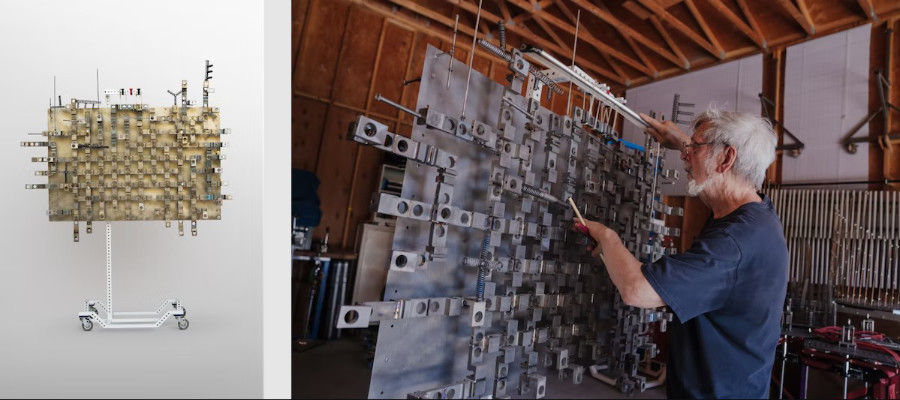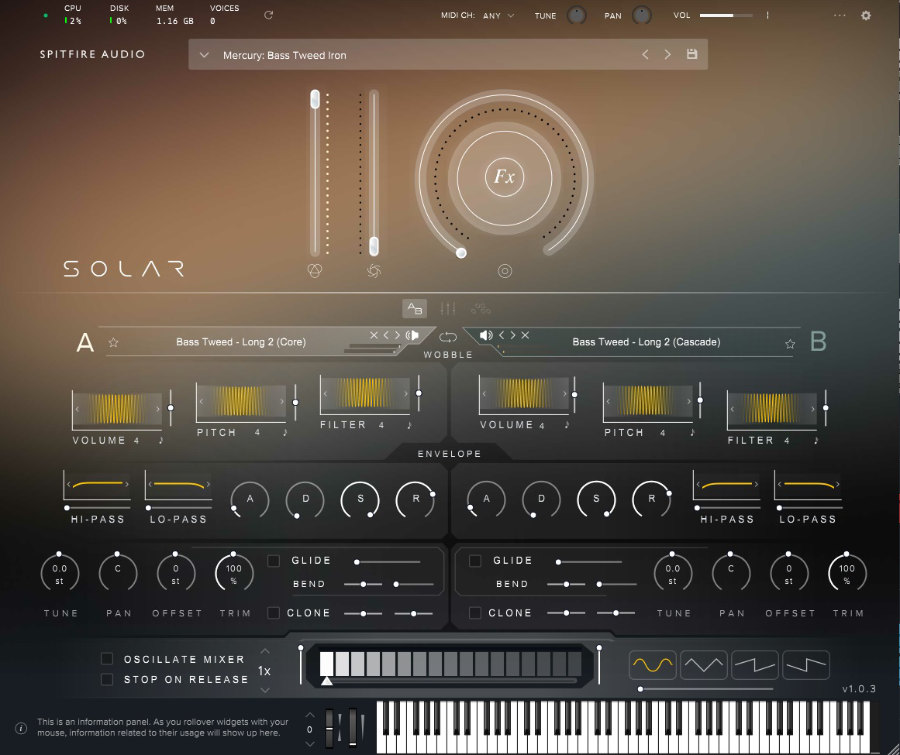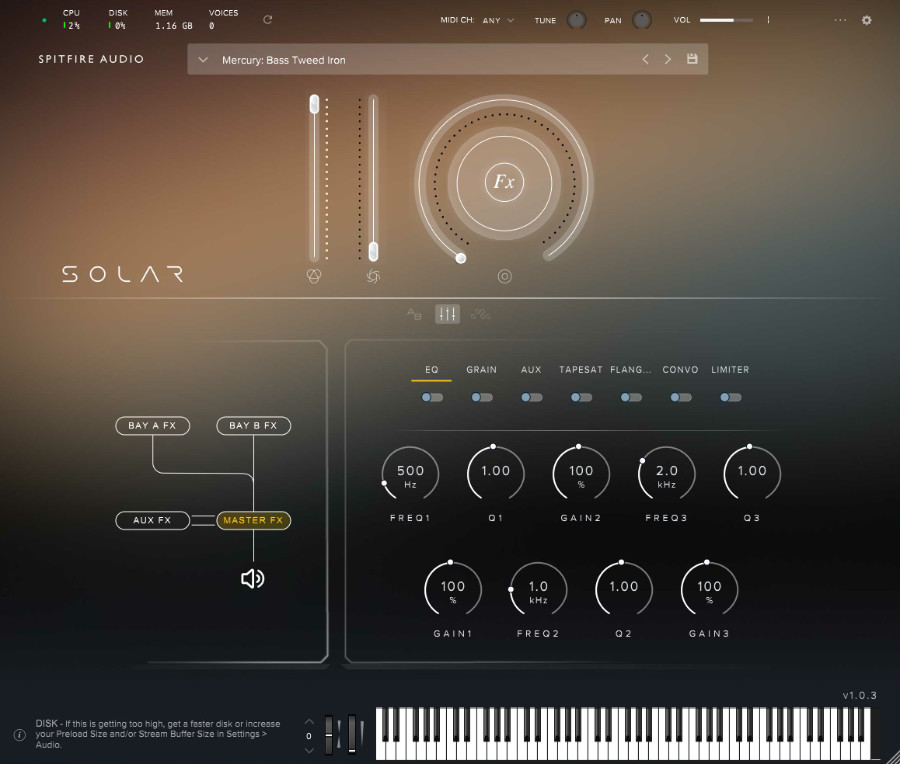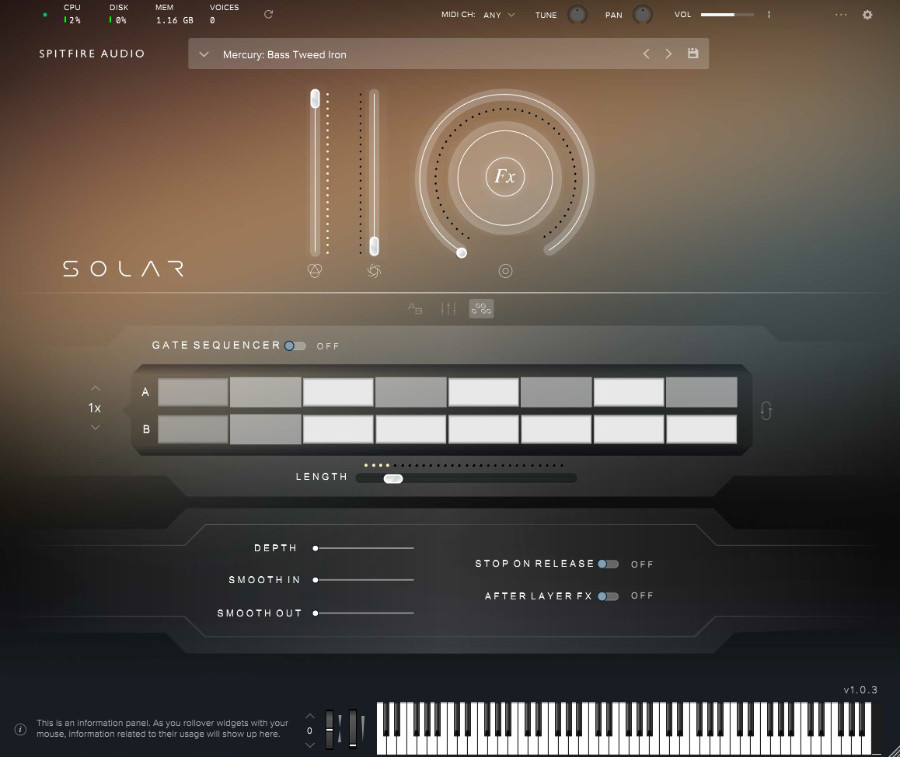Today we will be reviewing Mercury, the latest synthesizer addition to Spitfire Audio’s catalog. Released a few weeks ago, the aim of this library is to provide otherwordly sounds and textures based on really unique instruments, at a very affordable price.
Spitfire Audio kindly provided us with a review copy to check Mercury out.
OVERVIEW
Spitfire Mercury is a user-friendly software synthesizer that features a selection of 14 unique instruments handcrafted by legendary Chas Smith.
Spitfire Audio’s Mercury ships as its own plugin with more than 600 presets that are structured into pads, textures, and single hits. The plugin also includes non-processed samples that were captured directly from the 14 real-world custom instruments. All in all, Mercury requires 8.2 GB of hard drive space.
CHAS SMITH – A BLACKSMITH OF MUSICAL INSTRUMENTS

Chas Smith is a composer and one of Hollywood’s most sought-after instrument builders. He worked on various recent big blockbusters such as Man of Steel, Dune, Interstellar, Dunkirk, and Jigsaw, just to name a few. Over the years he invented many unique custom instruments that have been used most notably by iconic film composer Hans Zimmer.
After trying various jobs and activities, Chas Smith eventually had a go at metal welding and crafting. Chas described this first try as just feeling right and natural, and he immediately fell in love with this line of work. To his surprise, he later discovered that some of his ancestors used to work as blacksmiths.
Over the following years, his successful welding activities, combined with a very vivid imagination, gave Chas the opportunity of collaborating with various sculptors and visual artists. Being a big music fan, Chas also learned to play guitar at a professional level. His life took an inspiring turn when he discovered the works of Harry Partch. Harry Partch was a unique composer who wanted to go beyond the standard musical scales. Partch was known for composing with microtonal scales and creating many unique instruments.
Fast forward a few years, having now acquired a significant experience in welding and metal crafting, Chas Smith started creating his very own musical toolbox. By giving life to custom-made, peculiar instruments that could produce distinctive sounds and resonances, he composed many textural musical tracks of his own. Chas’ unique skills eventually led him to contribute to famous movie scores, working with the likes of Hans Zimmer, Thomas Newman, Charlie Clouser, Jeff Danna, and more.
INTERFACE
Mercury is powered by a new plugin called Solar, which is based on Spitfire Audio’s proprietary sample players. Users of other recent Spitfire Audio products like the Albion range or eDNA Earth will instantly recognize similarities in the layout with the eDNA interface, and it is indeed this very same eDNA engine that is running under the hood here.

As you can see, the plugin is organized into 2 bays (A & B), each containing a freely selectable sound source. Below these, you can find various parameters for manipulating each individual bay: oscillators, filters, envelope controls, and a few others. With two sound sources available, the bottom mixer can be used two balance your overall sound or even oscillate between the two at different rates – all in sync with your DAW’s tempo of course.
The effects page contains various parameters, such as a talk box effect, an amp, a distortion, and a flanger, just to name a few. Other more general effects can also be added to the master output at the end of the signal chain. These effects include a delay, tape saturation, and reverb.

Finally, a third page is dedicated to Solar’s gate sequencer. The gate sequencer is very visual and easy to use: just select the “active steps” you want to hear and modify the length and speed of the overall sequence. This can be accomplished with just a few clicks.

ARTICULATIONS & CONTENT
As you can probably guess, Mercury’s strength lies in the variety of its distinctive sounds. On that front, the library delivers an impressive array of quite unique samples. There are around 120 non-processed sound sources, and several hundred presets derived from them. Besides that, users can obviously design their very own sounds using the easy-to-use interface.
Going through the different raw sound sources, we can find several types of sounds: single hits, textures, evolving sustains, and bowed sounds. There are a lot of choices offered here to kickstart inspiration with enough material for hundreds of cues.
The presets themselves feature a lot of variety and offer even more tonal combinations. There are a lot of interesting, evolving textures ready to use which makes the library very suitable for textural works. On that note though, we did notice that the very useful “preview” function in the sample list would randomly not work, despite the samples being loaded in memory.
Sound-wise, these custom instruments are built with metals, and a lot of the samples share a metallic timbre. That is carried over to the preset patches of course. Regardless of the heavy post-processing effects applied to those patches, most of them have some sort of metallic “shine” in their upper frequencies.

A lot of the curated samples also do not have a clearly defined pitch, as they show a lot of inharmonic material (particularly in the upper-frequency range). As a result, the library seems to be particularly well suited for adding atmospheric and non-tonal elements to music tracks. This means, however, that it may be less suited to be used as a melodic instrument.
Overall, these atonal characteristics really define the content of Mercury, and, at the risk of making the samples a bit niche, really give the library a unique quality. The single-hit elements are also quite varied and a very welcome addition, I just wished Spitfire Audio would have recorded several round-robins for these to make them sound a bit more organic when played in a rhythmic fashion.
I wrote a short demo track, inspired by the movie Dune, showcasing the atmospheric and almost extraterrestrial nature of many of Mercury’s samples. The demo is written with some third-party instruments including the vocals, the duduk, and the percussion bed.
CONCLUSION
Mercury is a very intriguing release and presents a nice contrast to the more orchestral products we know from Spitfire Audio. Secluded from any famous recording locations and studios, this release aims at providing peculiar and otherworldly sounds at an affordable price. In that respect it fully delivers.
Packed with varied samples and options for creative sound manipulation, Mercury will be a particularly good fit for composers looking to design their own sonic space and add a strong vibe and unique character to their tracks.
Pros
- Great selection of unique sounds in a compact library
- Well-curated collection of presets
- Many sound manipulation options included within the Solar plugin
Cons
- No round robins for single hit samples
- Preview function didn’t work properly in our review copy
Mercury is available as a download for $ 149/€ 149 via Spitfire Audio’s online shop.


0 comments on “Spitfire Audio – Mercury (Review)”